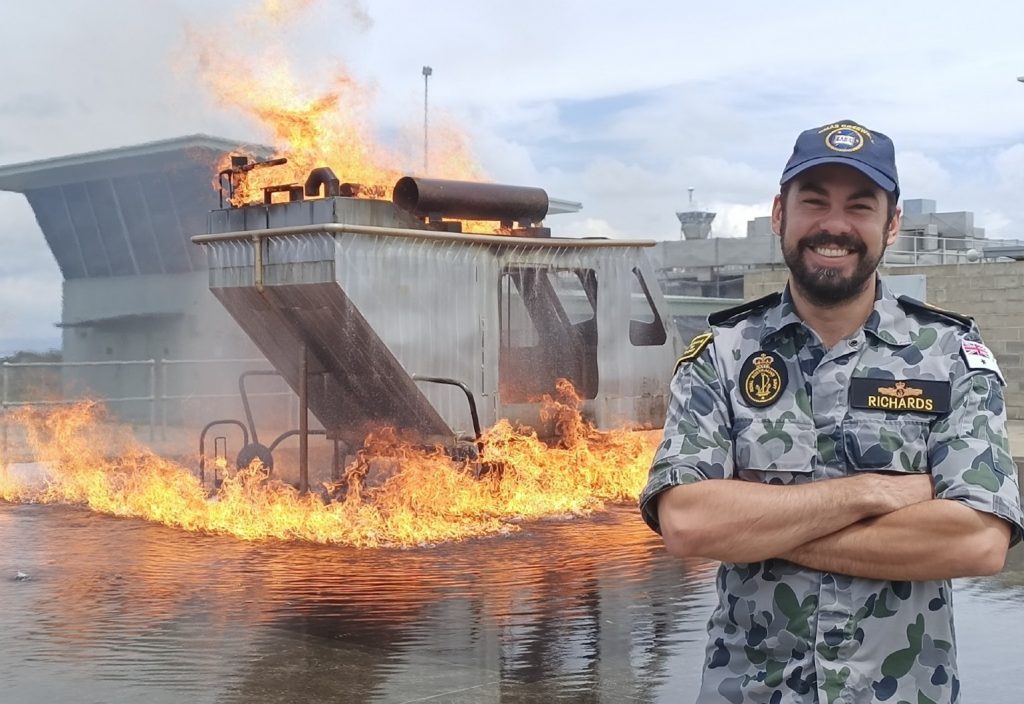Damien Richards is a Chief Petty Officer Marine Technician in the Royal Australian Navy. His role in marine engineering has taken him on humanitarian missions in the Pacific and taught him a lot about the world and operating in the maritime environment.
“I chose a career in engineering because right from a young age, I would spend time with my dad working on our boat, installing and fixing both mechanical and electrical systems,” Damien Richards told create.
Joining the Navy straight out of school at 17, he went through the trade route and undertook his training at HMAS Cerberus, located on Victoria’s Mornington Peninsula.
“As a Marine Technician, we have three trade streams — propulsion, hull and electrical — with the opportunity to specialise within these streams” he said.
“Once you have chosen your trade, you’re considered the subject matter expert in that particular stream and your career development is focussed on further developing these skills.
“You will be posted into billets that focus on the utilisation and upskilling of your specialisation to maintain and operate that particular equipment, but there’s always an expectation that you can and will be called upon to assist with any maintenance or defect rectification activity,” he said.
Richards’ first posting after training was HMAS Cairns, before then serving a number of years on the landing craft heavy (LCH) HMAS Wewak.
“I was promoted from Seamen, to Able Seaman and then Leading Seaman on the same vessel, which was quite fortunate for me, as I absolutely loved that posting,” he said.
Richards did another three postings before being sent to his current role as Senior Instructor at HMAS Creswell in Jervis Bay, NSW, teaching at the School of Survivability and Ship Safety.
A day in the life
“In my current role, I manage and conduct firefighting, leak stop and repair for flooding, as well as CBRN [chemical, biological, radiological and nuclear defence] training activities for both new entry officers as well as advanced training to fleet personnel,” he said.
Richards has also been deployed on Operation Resolute, Anode, Pacific Partnership and PNG Assist providing humanitarian aid, peacekeeping and disaster relief.
“Working on aid missions in the Pacific Islands is my career highlight to date,” he said. “You get to see firsthand how other cultures both live and survive in extremely isolated areas. It makes you realise just how much we take for granted but that happiness can also be found in any situation.”
From an engineering perspective, Richards said he has been fortunate to work on both innovative technology as well as some of the Navy’s oldest equipment — with the oldest proving the most rewarding.
“During your initial years as a Seaman and an Able Seaman, you’re exposed to everything — propulsion systems [diesel, gas turbine and electric], power generation, electrical distribution systems, steering gear systems, for example — every system conceivable needed to operate a ship at sea,” he said.
Along with holding a Marine Technical Charge Certificate, Richards is currently undertaking a Masters in Systems Engineering at the University of New South Wales, which he finds valuable for rethinking problem solving, both in the technical and personnel fields.
“Prior to studying systems engineering, I found that I’d focus on a problem and not see the external influences impacting that particular problem,” he said.
“It has taught me to be more analytical and critical in my thinking, changing how I approach technical problems, but also the management of my people in the sense that I now look for cause and effect as well as how I can influence the problem space.”
As for young engineers who may want to follow in his footsteps in the Navy, he said the most important thing to understand is that it is a lifestyle.
“You’re a sailor, as well as an engineer. Because of that, we enjoy a variety of work that’s not always technical and not always familiar, daily,” he said.
“If you’re interested in job variety, diversity amongst your ‘oppos’ [co-workers], managing and operating high-end engineering systems whilst serving your country, this is definitely the job for you.”
